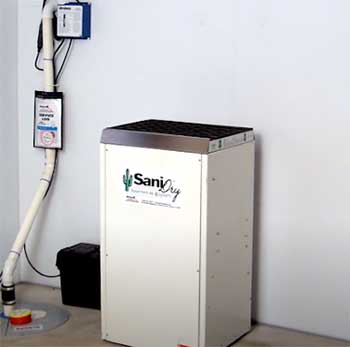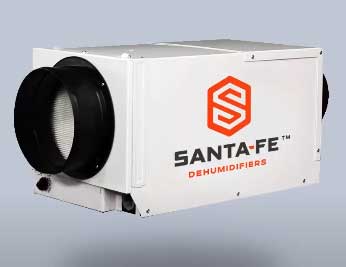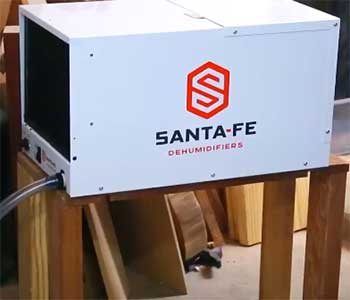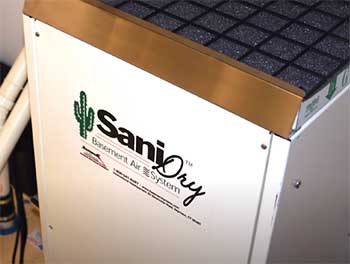Dehumidifiers are an essential appliance for any homeowner looking to control moisture and humidity levels indoors. Two of the most popular dehumidifier brands on the market are SaniDry and Santa Fe.
But with so many models to choose from, how do you know which brand and model is right for your home?
In this comprehensive guide, we’ll compare the key features, pros and cons of SaniDry and Santa Fe dehumidifiers to help you make an informed decision. We’ll look at capacity, coverage area, noise levels, efficiency ratings, warranties and other important factors.
Read on to learn which dehumidifier suits your needs.
Comparison Chart
| Features | SaniDry | Santa Fe |
| Type | Desiccant and refrigerant | Refrigerant only |
| Capacities | 25-85 pints/day | 35-155 pints/day |
| Coverage | 500-6500 sq ft | 500-2500+ sq ft |
| Noise Levels | 41-56 dB | 50-66 dB |
| Efficiency | 1.8-5.2 pints/kWh | 1.8-3.0 EF |
| Drainage | Built-in pump, gravity | Pump kit, gravity |
| Filters | MERV-8 to MERV-13 | MERV-8 |
| Controls | Digital humidistat, multi-fan speeds | Humidistat on some models |
| Warranty | 1-2 years | 1-5 years |
| Price Range | $150-$450 | $175-$700 |
Overview of SaniDry Dehumidifiers
SaniDry is owned by De’Longhi Appliances and specializes exclusively in dehumidifiers for home use. Some of their most popular models include:

- SaniDry Sedona – their flagship desiccant dehumidifier line with capacities from 25 to 45 pints per day. Known for continuous operation and very low humidity levels.
- SaniDry Crawler – a compact, rolling dehumidifier line from 30 to 85 pint capacities. Features caster wheels and automatic humidity control.
- SaniDry Mini – their small, portable refrigerant dehumidifier line under 50 pint capacities. Ideal for bathrooms, closets and confined spaces.
In general, SaniDry dehumidifiers are designed for effectiveness and convenience.
Many of their models have built-in pumps to drain water automatically, continuous drain options, timers, full bucket alerts and auto-restart after power outages.
They’re also quite user-friendly with controls and displays that are intuitive to operate.
Overview of Santa Fe Dehumidifiers
Santa Fe dehumidifiers are made by Therma-Stor LLC, a company that specializes in air quality products for indoor environments. Their most popular models include:

- Santa Fe Classic – their standard refrigerant dehumidifier line ranging from 70 to 105 pints per day. Known for quality construction but basic controls.
- Santa Fe Advance – high-capacity units from 135 to 155 pints per day. Features a humidistat and auto-restart.
- Santa Fe Compact – smaller portable units under 50 pint capacities. Lightweight and stackable design.
Santa Fe dehumidifiers are appreciated for their durability and reliability.
They have a reputation for being able to operate efficiently in cooler basements and garages. The downside is they tend to have less advanced features and controls compared to other brands.
But their simplicity makes them easy to operate and maintain.
Key Differences Between SaniDry And Santa Fe Dehumidifiers
Now that we’ve looked at a general overview of both brands, let’s go in-depth on how they compare in key categories:
Dehumidifier Type
The first major difference between SaniDry and Santa Fe is the dehumidifier technology they use:
- SaniDry offers both desiccant and refrigerant models. Their Sedona series are desiccant units that use a wheel coated with silica gel to absorb moisture. Desiccants remove humidity at lower temperatures and can maintain very low humidity levels.
- Santa Fe only makes refrigerant dehumidifiers. These work like air conditioners, cooling air on coils to condense moisture which gets collected in a bucket. Refrigerant types don’t work as well in cold environments.
Desiccant units like the SaniDry Sedona can continuously draw moisture at any temperature, making them more effective for damp basements. But they require more energy to run. Refrigerant models like Santa Fe are more energy-efficient overall, but lack the same dryness capabilities.
Dehumidifier Capacities
Both brands offer a wide range of capacities suitable for different room sizes:
SaniDry capacities:
- Sedona: 25-45 pints/day
- Crawler: 30-85 pints/day
- Mini: 30-45 pints/day
Santa Fe capacities:
- Classic: 70-105 pints/day
- Advance: 135-155 pints/day
- Compact: 35-45 pints/day
The larger Santa Fe Advance series offers the biggest capacities over 150 pints for very damp spaces up to 2500 sq ft.
But SaniDry has a wider diversity of options at lower capacities that are ideal for bathrooms, kitchens, RVs and confined areas.
When choosing capacity, make sure it’s suitable for the room size and moisture levels. Going too big wastes energy and money. Too small means the unit can’t adequately dry the space.
Coverage Area
Here are the approximate room sizes the different models can effectively dehumidify:
SaniDry coverage:
- Sedona 25-45 pint: 1000-2500 sq ft
- Crawler 30-85 pint: 1500-6500 sq ft
- Mini 30-45 pint: 500-1000 sq ft
Santa Fe coverage:

- Classic 70-105 pint: 2500-4000 sq ft
- Advance 135-155 pint: 2500+ sq ft
- Compact 35-45 pint: 500-1500 sq ft
For large basements or crawlspaces, the high-capacity Santa Fe Advance and SaniDry Crawler units are ideal.
The smaller Santa Fe Compact and SaniDry Mini work well in bathrooms, kitchens, and RVs.
Look for a dehumidifier that can provide adequate coverage for your room’s square footage.
This ensures it will be able to sufficiently remove moisture.
Noise Levels
Noise level is an important factor, especially if the dehumidifier will be used in livings spaces. Here’s how the brands compare:
SaniDry noise levels:
- Sedona series: 41-46 dB on low fan
- Crawler series: 51-56 dB
- Mini series: 50-55 dB
Santa Fe noise levels:
- Classic series: 56-60 dB
- Advance series: 60-66 dB
- Compact series: 50-55 dB
The desiccant SaniDry Sedona units are the quietest, running at noise levels just above a whisper. This makes them excellent choices for bedrooms and nurseries.
The Santa Fe Classic and Advance refrigerant models operate at higher decibel levels, closer to a normal conversation. The Compact units are quieter but not as silent as the Sedona series.
If the dehumidifier will be used in a living area, look for lower noise levels for uninterrupted comfort. Units with 55 dB or less allow for restful sleep.
Efficiency Ratings
Dehumidifier efficiency is measured by Energy Factor (EF) for refrigerant types and Pints/kWh for desiccants. The higher these numbers, the more moisture is removed per energy consumed.
SaniDry efficiency:
- Sedona series: 2.9-5.2 pints/kWh
- Crawler: 2.2-2.8 pints/kWh
- Mini: 1.8-2.2 pints/kWh
Santa Fe efficiency:
- Classic: 1.8-2.2 EF
- Advance: 1.8-3.0 EF
- Compact: 1.8-2.2 EF
The desiccant Sedona dehumidifiers achieve incredibly high efficiencies over 5 pints per kWh. This results in lower energy costs for their level of moisture removal.
The Santa Fe models have decent Energy Factor ratings for refrigerant types. But they consume more energy overall compared to equivalently sized desiccant units.
Look for higher pint/kWh or EF scores to save on running costs. Energy Star certified models indicate the highest ratings.
Drainage Options
Dehumidifiers collect condensation in buckets that need regular emptying. But many units have drainage options for continuous operation:
SaniDry drainage:
- Built-in pump: Sedona, some Crawler models
- Gravity drain: All models
Santa Fe drainage:
- External pump kit: Some Classic models
- Gravity drain: All models
Having a built-in or add-on pump allows the unit to automatically drain itself. This allows for continuous drainage and uninterrupted operation.
All the models also allow for gravity drainage by simply attaching a hose to drain water to a floor drain or sink.
Look for built-in pumps or pump kit options if automated drainage is preferred. Otherwise gravity drainage works but needs occasional manual emptying.
Filters
Dehumidifiers pull a lot of air to remove moisture. So it’s important they have quality filters to catch dust and allergens. Here are the filter types:
SaniDry filters:
- Sedona: MERV-13 pleated fabric
- Crawler: MERV-8 pleated fabric
- Mini: Standard mesh
Santa Fe filters:
- All models: MERV-8 pleated fabric
The advanced MERV-13 filters on the SaniDry Sedona remove more allergens like pet dander, mold spores and dust mites.
Santa Fe units have decent MERV-8 filtration. The basic mesh filters on the SaniDry Mini models are less effective for air purification.
Look for MERV-13 or the highest MERV rating possible for cleaner, healthier air.
Humidistat and Controls
The humidistat and controls allow adjusting humidification settings and fan speeds. Here are the options:
SaniDry controls:
- Digital humidistat: All models
- Fan speeds: 2-3 options
Santa Fe controls:
- Humidistat: Advance models
- Fan speeds: 1-2 options
All models allow adjusting target humidity from 35-80%. The SaniDry units also have multiple fan speeds for customized drying.
The Santa Fe Advance models have built-in humidistats. The Classic models require adding an external humidistat.
Digital controls with a humidistat allow setting precise moisture levels. Look for multiple fan speeds for the most adjustment flexibility.
Warranties
The warranty provides an indication of the expected reliability and longevity:
SaniDry warranties:
- Sedona & Crawler: 2 years
- Mini: 1 year
Santa Fe warranties:
- Classic & Advance: 5 years
- Compact: 1 year
The Santa Fe Classic and Advance units come with outstanding 5-year warranties demonstrating long-term durability. The SaniDry models have shorter 1-2 year coverage.
Look for the longest warranty possible for your purchase, as it reflects manufacturer confidence in the product. 5 years is ideal for regular use.
Pricing
Here are the typical retail price ranges:
SaniDry pricing:
- Sedona: $200 – $350
- Crawler: $250 – $450
- Mini: $150 – $200
Santa Fe pricing:
- Classic: $250 – $400
- Advance: $450 – $700
- Compact: $175 – $250
Across comparable capacities, the pricing is quite similar. Larger units over 5000 sq ft capacities run higher. The compact models are lowest cost.
On average, expect to budget $200-400 for smaller units up to 2000 sq ft coverage, and $400+ for larger dehumidifiers.
Key Pros and Cons of SaniDry And Santa Fe Dehumidifiers
SaniDry Pros:

- Excellent dehumidification from desiccant models
- Very quiet operation on lower settings
- Lots of drainage flexibility
- Range of capacities for all room sizes
SaniDry Cons:
- Desiccant models are more expensive to operate
- Shorter warranties
- Basic air filtration on some models
Santa Fe Pros:
- Very effective for cold/damp basements
- Low operating costs with refrigerant design
- Long 5-year warranties on many models
- Simple and durable construction
Santa Fe Cons:
- Lacks advanced features and settings
- High noise levels on larger units
- External humidistat required for some models
- Air filtration not as robust as other brands
Which Is Better: Sanidry Or Santa Fe?
When choosing between SaniDry and Santa Fe dehumidifiers, here are a few key factors to help decide:
- Room size – SaniDry offers greater size diversity from compact to large capacities. Santa Fe excels at big rooms.
- Home location – Cold climates suit Santa Fe’s refrigerant units better. SaniDry works anywhere.
- Noise – SaniDry dehumidifiers operate much quieter, making them better for living areas.
- Advanced features/controls – SaniDry has more accuracy, settings, drainage flexibility. Santa Fe is simpler.
- Air filtration – SaniDry sedona units have superior MERV-13 filtration.
- Price – Comparable capacities have similar price ranges. Santa Fe has longer warranties.
Frequently Asked Questions (FAQ)
Yes, Santa Fe makes very effective and reliable dehumidifiers. They specialize in heavy-duty refrigerant models that excel at moisture removal in damp, colder environments like basements. Santa Fe units are appreciated for their simple, durable builds and long 5-year warranties.
Santa Fe dehumidifiers are manufactured by Therma-Stor LLC. Headquartered in Madison, Wisconsin, they are a leading producer of air quality products for indoor environments.
With proper maintenance, Santa Fe dehumidifiers typically last between 5-8 years. The units are built simply without a lot of parts that can break. And they come with outstanding 5-year warranties covering defects. So with regular filter cleaning and upkeep, a Santa Fe dehumidifier can provide lasting performance.
SaniDry dehumidifiers are produced by De’Longhi Appliances. Based in Italy, De’Longhi makes several home appliance brands sold internationally. Known for quality and innovation, they have been in business since 1902.
Final Thoughts
Overall, SaniDry is the better choice if you need whisper-quiet operation, maximum moisture removal at any temperature, smaller size capacities, and advanced air filtration.
Santa Fe is ideal if you want in-depth dehumidification for large, cold spaces and appreciate a durable, no-frills design backed by long warranties.
Either brand works well to control humidity and prevent mold and mildew. Look for the right pint capacity, features, and price-point for your needs. And consider an Energy Star model for the greatest savings.
With a quality dehumidifier matched to your space, you’ll enjoy cleaner, healthier indoor air.
